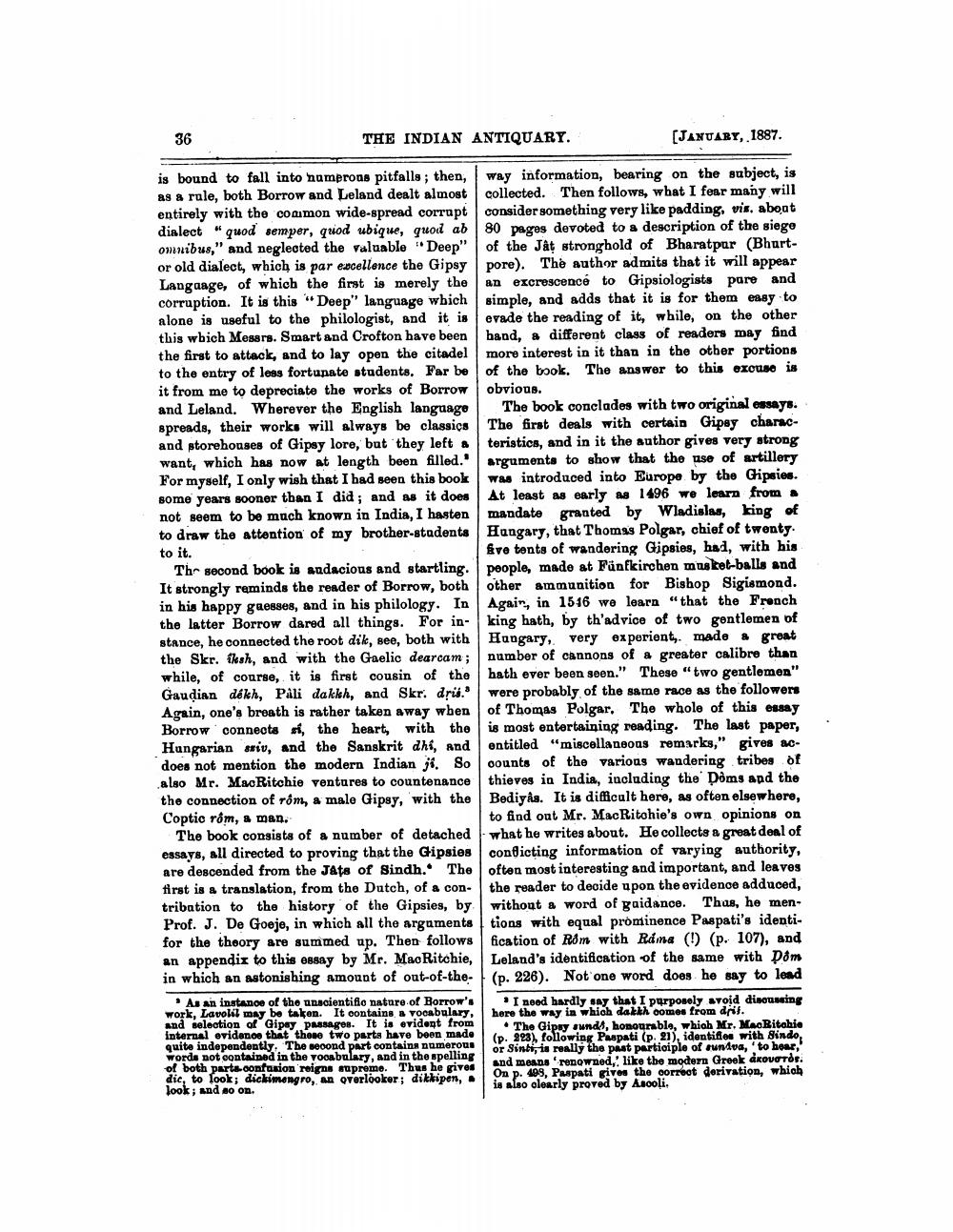________________
36
THE INDIAN ANTIQUARY.
(JANUARY, 1887.
is bound to fall into namerons pitfalls; then, way information, bearing on the subject, is as a rule, both Borrow and Leland dealt almost collected. Then follows, what I fear many will entirely with the common wide-spread corrupt consider something very like padding, vis, aboat dialect "quod semper, quod ubique, quod ab 80 pages devoted to a description of the siege omnibus," and neglected the valuable "Deep" of the Ját stronghold of Bharatpur (Bhartor old dialect, which is par excellence the Gipsy pore). The author admits that it will appear Langaage, of which the first is merely the an excrescence to Gipsiologists pare and corruption. It is this Deep" language wbichsimple, and adds that it is for them easy to alone is useful to the philologist, and it is evade the reading of it, while, on the other this wbich Messrs. Smart and Crofton have been band, a different class of readers may find the first to attack, and to lay open the citadel more interest in it than in the other portions to the entry of less fortunate students. Far be of the book. The answer to this exouse is it from me to depreciate the works of Borrow obvious. and Leland. Wherever the English language The book conclades with two original essays. spreads, their works will always be classics The first deals with certain Gipsy characand storehouses of Gipsy lore, but they left a teristics, and in it the author gives very strong want, which has now at length been filled.' arguments to show that the use of artillery For myself, I only wish that I had seen this book was introduced into Europe by the Chipsies. some years sooner than I did ; and as it does At least as early as 1496 we learn from a not seem to be much known in India, I hasten mandate granted by Wladislas, king of to draw the attention of my brother-stadents Hungary, that Thomas Polgar, chief of twenty to it.
kve tents of wandering Gipsies, had, with his The second book is audacious and startling. people, made at Fünfkirchen muskel-balls and It strongly reminds the reader of Borrow, both other ammunition for Bishop Sigismond. in his happy gue8808, and in his philology. In Again, in 1516 we learn that the French the latter Borrow dared all things. For in- king hath, by th'advice of two gentlemen of stance, he connected the root dik, see, both with Hungary, very experienty. made & great the Skr. ikesh, and with the Gaelic dearcam; number of cannons of a greater calibre than while, of course, it is first cousin of the bath ever been seen." These “two gentlemen" Gaudian dekh, Pali dakkh, and Skr. drü. were probably of the same race as the followers Again, one's breath is rather taken away when of Thomas Polgar. The whole of this essay Borrow connects si, the heart, with the is most entertaining reading. The last paper, Hungarian sriv, and the Sanskrit dhi, and entitled "miscellaneous remarks," gives acdoes not mention the modern Indian ii. So oounts of the various wandering tribes of also Mr. MacRitchie ventures to countenance thieves in India, including the Dôms and the the connection of rôm, a male Gipsy, with the BediyAs. It is difficult here, as often elsewhere, Coptic rốm, 4 men,
to find out Mr. MacRitohie's own opinions on The book consists of a number of detached what he writes about. He collects a great deal of essays, all directed to proving that the Gipsies conficting information of varying authority, are descended from the Jats of Sindh. The often most interesting and important, and leaves first is a translation, from the Dutch, of a con- the reader to decide upon the evidence adduced, tribation to the history of the Gipsies, by without a word of gaidance. Thas, he menProf. J. De Goeje, in which all the arguments tions with equal prominence Paspati's identifor the theory are summed up. Then follows fication of Rom with Ráma (1) (p. 107), and an appendix to this essay by Mr. MacRitchie, Leland's identification of the same with Dom in which an astonishing amount of out-of-the- (p. 226). Not one word does he say to lead
As an instance of the anscientifio nature of Horrow's I need hardly say that I purposely avoid discussing work, Lavokil may be taken. It contains a vocabulary, here the way in which dalth comes from dit. and selection of Gipsy passages. It is evident from
• The Gipsy sundy, honourable, which Mr. MacRitahia internal ovidenon that those two parts have been made quite independently. The second part contains numerous
(p. 923), following Paspati (p. 21), identifies with Sindo, words not oontained in the vocabulary, and in the spelling 1
or Sinti, is really the past participle of rundva, to boar, of both parts confusion reims supreme. Thus he gives
and means renowned, like the modern Greek kovotor. dic, to look; dickimangro, an overlooker; dikkipen, .
On p. 409, Paspati gives the corroot derivation, which look; and so on.
is also clearly proved by Anooļi.




